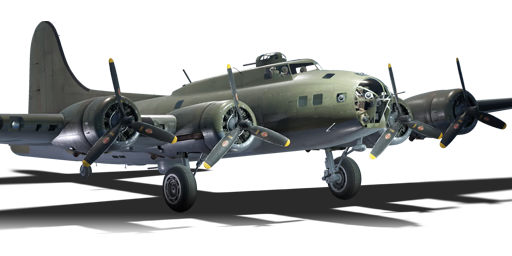



The B-17 Flying Fortress is one of the most iconic USAF bombers of WWII. The B-17E was the first version of the Flying Fortress produced in large numbers, with 512 delivered. Unlike previous versions, the B-17E had larger and extended fuselage by 3m, as well as a vertical tailfin, rudder, and horizontal stabilizer added. A new tail gunner position was made in the new fuselage, dorsal and remotely operated ventral turret made by Sperry were also added. All these modifications also increased the aircraft's weight by about 20%, so a more powerful version of Wright R-1820 Cyclone 9 engines were used.
In the game since the start of the Open Beta Test prior to Update 1.27, the B-17E is the first USAF heavy bomber that pilots will come across in the US tree. The legendary Flying Fortress features excellent defensive armament consisting of over 10 x 12.7 mm machine guns spread across multiple turrets, paired with decent bomb load of up to 8,000 lb of ordnance, which is enough to destroy two bombing points. However, the B-17's wings are very fragile, so caution is advised when turning so as not to overload them.
flaps
flaps
flaps
brake
| Belt | Belt filling | Armor penetration (mm) at a distance: | |||||
|---|---|---|---|---|---|---|---|
| 10 m | 100 m | 500 m | 1000 m | 1500 m | 2000 m | ||
| T/AP/I/AP-I | 30 | 27 | 20 | 13 | 9 | 6 | |
| AP/AP/AP/T | 30 | 27 | 20 | 13 | 9 | 6 | |
| AP-I/AP-I/AP-I/T | 28 | 26 | 18 | 11 | 7 | 4 | |
| Belt | Belt filling | Armor penetration (mm) at a distance: | |||||
|---|---|---|---|---|---|---|---|
| 10 m | 100 m | 500 m | 1000 m | 1500 m | 2000 m | ||
| T/AP/I/AP-I | 30 | 27 | 20 | 13 | 9 | 6 | |
| AP/AP/AP/T | 30 | 27 | 20 | 13 | 9 | 6 | |
| AP-I/AP-I/AP-I/T | 28 | 26 | 18 | 11 | 7 | 4 | |
| Belt | Belt filling | Armor penetration (mm) at a distance: | |||||
|---|---|---|---|---|---|---|---|
| 10 m | 100 m | 500 m | 1000 m | 1500 m | 2000 m | ||
| T/Ball/Ball/AP/I | 13 | 12 | 7 | 3 | 2 | 0 | |
| T/AP/AP/AP/I | 13 | 12 | 7 | 3 | 2 | 0 | |












Flight performance | |
|---|---|
Survivability |
|---|
Weaponry | |
|---|---|
